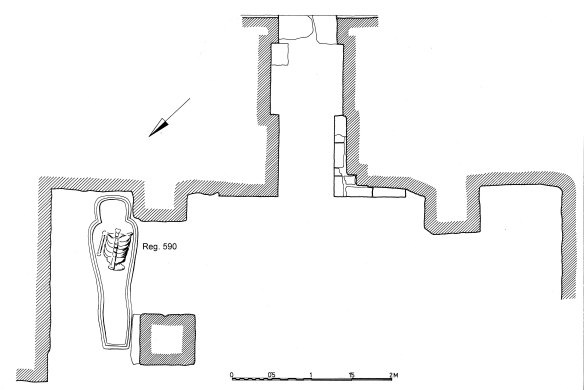TT 414, the monumental tomb of Ankh-Hor, High Steward of the Divine Adoratrice Nitocris during the 26th Dynasty (6th century BCE), is one of the so-called temple tombs of the Late Period in Asasif with a temple-like superstructure and complex cultic rooms and halls.

Within the current Ankh-Hor Project of LMU Munich we are focusing on the complete use-life of the tomb which lasted over centuries well into the Roman and Coptic periods. We also include the various ancient and more recent plundering phases of TT 414 which are well attested. One aspect is particularly noteworthy: TT 414 has the potential to serve as a case study to analyse various attitudes of later generations towards the original owners of Theban burial places. For example, several Late Period coffins had been found in the pillared hall of TT 414, thus not in their primary position within the burial chambers at the bottom of the various shafts, but within one of the cultic rooms or sanctuaries. In the entrance area to the pillared hall, a well preserved lower part of a coffin, Reg. No. 590, was discovered, seemingly out of place for a 26th Dynasty coffin.

Location of Reg. No. 590 in Room 4 of TT 414 (after Budka 2010).
Already back in the 1970s, the excavators suspected that these coffins had just been re-used in the Ptolemaic period when people started to make use of the pillared hall as a burial place (in addition to the shafts). In 2009, I could confirm this by an exceptional in situ-find that came to light during the cleaning of the coffin Reg. No. 590 (Budka 2010): We discovered in the interior of this 26th Dynasty coffin for a man named Iret-her-rw, called Nes-ba-neb-djedet, an intact mummy label with a demotic docket (see Budka and Mekis 2017). This Ptolemaic mummy label identifies the mummy placed in this coffin as a man with the name Wah-ib-Re. Recently, I could trace together with my colleague Tamás Mekis a fragmentary cartonage in the Louvre (Louvre N 4603) which probably belongs to this person and must derive from TT 414 as well (Budka and Mekis 2017).
This allows tackling two important aspects:
1) The destroyed mummy placed in the coffin Reg. No. 590 illustrates the well-known fact that in the 19th century AD, Egyptian mummies were systematically damaged during the search for gilded parts, cartonages, amulets and other finds. Objects like the cartonage Louvre N 4603 came via antiquity dealers to large European museums. Like for Wah-ib-Re, it is therefore possible to find various objects from people buried in TT 414 in these museums (see, e.g. Budka, Mekis and Bruwier 2013).
2) The Ptolemaic mummy label found in the 26th Dynasty coffin in TT 414 attests to the re-use of wooden coffins from the original phase of use of monumental temple tombs like TT 414 some 300 years later. Whether this re-use had simply practical reasons and a financial motivation, or whether this recycling was also associated with a more complex set of meanings must remain open for now, providing a number of possible lines of further research.

Final cleaning of Reg. No. 590 is well in progress.
I am personally very delighted that this not only beautifully painted, but also intriguing coffin, Reg. No. 590, which already has had such a multifaceted biography, now entered another aspect of its life history: it is getting a last cleaning and consolidation in order to be transported to the main magazine here on the West Bank as final resting place.
References
Budka, Julia 2010. Varianz im Regelwerk. Bestattungsabläufe im Monumentalgrab von Anch-Hor, Obersthofmeister der Gottesgemahlin Nitokris (TT 414), Ägypten & Levante 20, 49–66.
Budka, Julia, Tamás Mekis and Marie-Cécile Bruwier 2013. Re-use of Saite temple tombs in the Asasif during the early Ptolemaic time – the tomb group of Mw.t-Mnw from TT 414, Ägypten & Levante 22/23, 2012/2013, 209–251.
Budka, Julia and Mekis, Tamás 2017. The Family of Wah-ib-Re I (TT 414) from Thebes, Ägypten & Levante 27, 219‒240.
